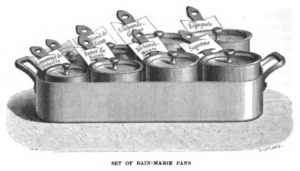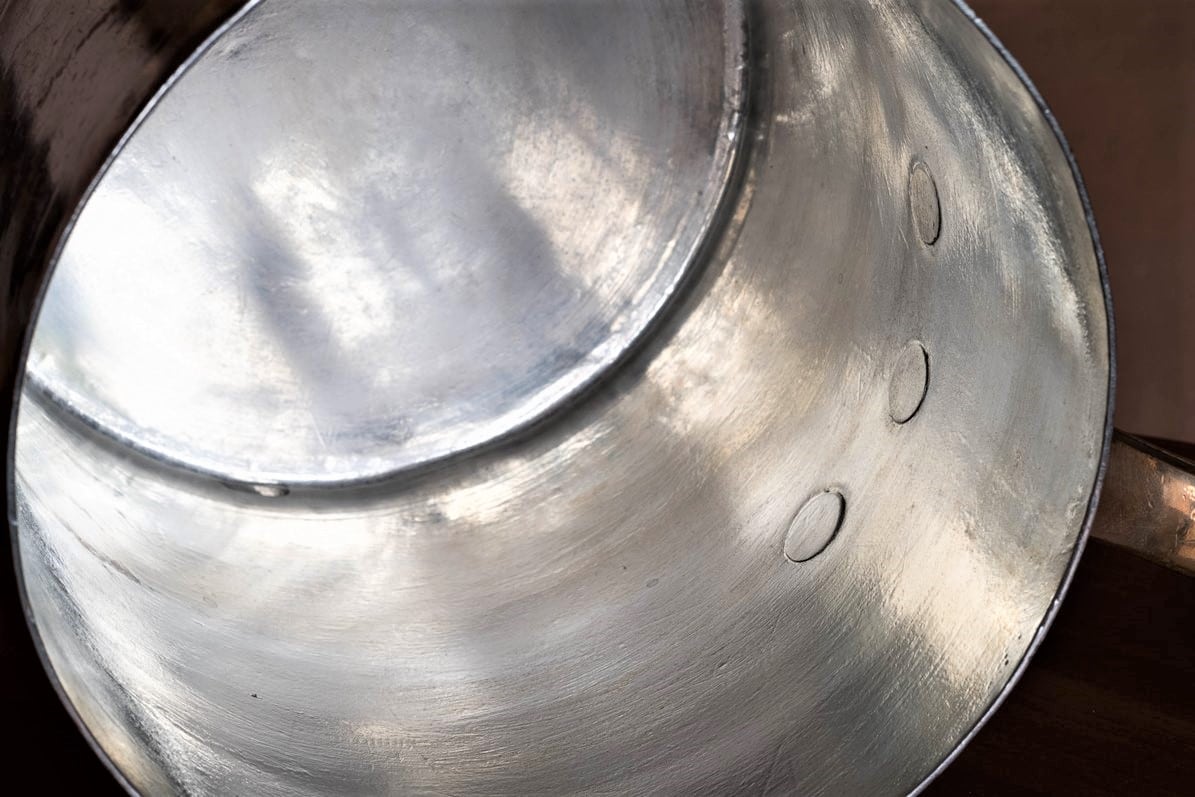This pot is both lovely and sturdy, befitting its Swiss-English heritage.

- Type: Bain-marie with bell metal handle attached with three copper rivets, and lid with bell metal handle attached with one rivet on each bracket
- French description: Bain-marie avec poignée en airain munie de trois rivets en cuivre et couvercle avec poignée en airain munie d’un rivet sur chaque côté
- Dimensions: 20.5cm diameter by 23cm tall (8.1 by 9.1 inches)
- Weight: 3714g (8.1 lbs), 4207g (9.3 lbs) with lid
- Stampings: “Leon Jaeggi and Sons Ltd Manufacturing Coppersmiths London and Staines”; etched “SPH 116”; “08” near base
- Maker and age estimate: Léon Jaeggi, post-1945
- Owner: Martin
 This beautiful pot is tall and narrow like a soup pot but with its projecting stick handle it’s more likely that it was intended as part of a bain marie set. A bain marie is a form of double boiler: a bath of warm water (traditionally, seawater) kept at a high simmer to create a steady temperature around an inner pot with a delicate sauce. An antique bain marie set consisted of a rectangular outer container resembling a roasting pan with several smaller pots that nestled within it. A busy restaurant would fill the outer pan with a few inches of water (preferably seawater to reduce evaporation, hence the “marie” of the name), heat it up to a low simmer and keep an array of sauces and glazes at the ready for an evening’s worth of dinners.
This beautiful pot is tall and narrow like a soup pot but with its projecting stick handle it’s more likely that it was intended as part of a bain marie set. A bain marie is a form of double boiler: a bath of warm water (traditionally, seawater) kept at a high simmer to create a steady temperature around an inner pot with a delicate sauce. An antique bain marie set consisted of a rectangular outer container resembling a roasting pan with several smaller pots that nestled within it. A busy restaurant would fill the outer pan with a few inches of water (preferably seawater to reduce evaporation, hence the “marie” of the name), heat it up to a low simmer and keep an array of sauces and glazes at the ready for an evening’s worth of dinners.
That said, of course, this particular pot has utility well beyond tending to a sensitive sauce. First and foremost, it creates a relatively small footprint for its volume, making it a handy pot for a modern kitchen. As its owner Martin says, “I bought it because I needed something slim and tall for my tight ‘galley’,” and indeed a pot like this can help with multiple cooking tasks without hogging the cooktop. With the same narrow proportions as a soup pot, it reduces the exposed surface area for the liquids it holds and it can heat and simmer with less evaporative loss. It’s also quite handy for cooking long narrow shapes of pasta and for steaming asparagus. Many is the time I have hovered anxiously over a saucepan waiting for spaghetti to collapse into a water — a tall pot like this can immerse the entire length of the pasta in the water immediately.
It’s also quite a beautiful pot, showcased to advantage by Martin’s loving photography.

The horizontal bands around the exterior are an interesting element. They look almost like stacked rings, but if strips of copper had been welded or dovetailed together there would be evidence of soldering and a vertical seam where the strips were joined. As none of that is apparent, Martin thinks (and I agree) that this appearance is an intentional martelage pattern left by a rectangular hammer. It’s beautiful and distinctive, and as far as I can tell, unique to the work of its maker.


That maker is Léon Jaeggi & Sons, an English firm founded in 1919. According to oldcopper.org, the firm’s main workshop was at 29 Dean Street in London with additional storefronts on Tottenham Court Road and 77 Shaftesbury Avenue. Jaeggi is an Anglicized rendering of the Swiss name Jäggi and the company’s stamps include the Swiss cross as well as the Union Jack. During World War II the company’s factory in London was destroyed — “burned to the ground by mindless vandals,” as the company’s history page puts it — and the firm relocated its manufacturing to Staines, England. The firm ceased manufacturing its own products in the 1980s and shifted its business model to servicing the restaurant and catering industry and continues to operate to this day.
According to oldcopper.org, Jaeggi stamps with the words “London & Staines,” as shown on this pot, represent production after 1945.


In addition to the maker’s marks, this pot has two additions from its previous users. The “08” is likely a reference to the pot’s diameter in inches; the “SPH 116” could be an owner’s mark, but it also reminds me of a retinner in the US who tracked customer pans by etching them!


To me, the handle retains a distinctly Continental flavor. The baseplate resembles the French-style lozenge, whereas English-made pots tend to have either the more defined rectangular- or, on narrow pots like this, an arrow- or spade-shaped baseplate. The hanging loop is also the classic French teardrop and not the English keyhole. I wonder if this was a conscious design choice of Léon Jaeggi — in keeping with his retention of the Swiss flags in his company’s logo and copper stamp — to preserve his connection with continental Europe and its reputation for haute cuisine.


The base exhibits all-over hammering and a nice beveled edge. At the moment I believe a beveled plane around the base of a pot is more than just the turning of the corner, so to speak, but an intentional addition to work-harden the edge. In any event, whether intentional or not, it’s a lovely element of the pot.

The pot retains its original lid, which weighs 493g — about a pound — making it a nice substantial piece on its own. The bar handle is well-proportioned as well — looking at the photos below, one would not realize that the lid is merely 21cm (about 8 inches) across. This sense of proportion makes the lid look like a complete piece and not an accessory.


Martin had this particular pot restored by Stephen Pearse at Newlyn Tinning in Cornwall, England. Steve did a beautiful job inside and out, preserving the pan’s external character and giving the interior a layer of luminous pure tin.


I am really grateful to Martin for giving us the opportunity to enjoy the work of Léon Jaeggi in detail. It’s clear to me that this pot has been loved in the past — well tended and kept with its original lid — and now it’s in the hands of a new owner who will continue to cherish and use it. Thank you, Martin!






Hi,
beautiful pan, and as they are catering supplier anything stamped Leon Jaeggi is going to be good quality.
I find a tall pan really useful when I want to use an electric hand blender, no splattering the kitchen walls.
I am not entirely convinced this was ever part of a Bain marie as I think such pans were externally tinned to protect the copper from the salt water and although it is often worn or polished away there is usually some remnants especially round the handle.
Roger
Hey Roger! I could be talked out of calling it a Bain Marie pot, but I don’t know what else to call it. I have not come across a French term in the vast culinary panoply that captures tall-and-skinny-with-stick-handle. What would you say it is?
And I know what you mean about the absence of exterior tinning — I know from old catalogs that Bain Marie sets were usually tinned inside and out, but 20th century catalogs don’t show this. Perhaps people forgot about the salt water part of it and just used plain water…
Hi,
I wonder if it is a part of the traditional French batterie, I don’t recall seeing a French pan with these proportions. I think it is a soup pan that is just begging for you to coin a fancy name for it.
I have a couple of English Bain marie pans here one of which retains about sixty percent of the tin on the outside.
Ice cream bombes are not externally tinned and seem to survive quite well so maybe brine doesn’t do too much harm. Salt raises the boiling point of water but I don’t understand how it prevents evaporation.
Hi,
to my knowledge, the term “bain marie” is used differently. In an unromantic way, it is basically a water bath (or warming bath) consisting of at least 3 parts. A larger container with warm water, one or more containers with lids to keep food and sauces warm; the latter are immersed in the larger container. Many describe only one of these parts of such a combination as “bain marie”. Indeed, it does not seem unusual to also refer to some kinds of saucepans as “bain marie”, as can be seen on etsy or on ebay. As a high design with raised handle, these pans can be used in a water bath. Even a Charlotte shape is offered at etsy as “bain marie”. Others refer to large rectangular shapes that are otherwise known as roasters, as water baths or “bain marie”. Many combinations can be used as a “bain marie”. I myself occasionally use a round-shaped Windsor design saucepan to beat a hollandaise sauce or similar sauces, placing the Windsor-shaped pan in a lager saucepan (warming bath) of a suitable size.
On the net you can find small modern variants (eg made by Mauviel), huge professional ones and a few very interesting antique ones similar to the ancient set VFC found.
Martin